Home![]() Research description
Research description![]() Theme IV
Theme IV
Research description
Theme V. Terahertz time-domain spectroscopy B: Emission from coherent longitudinal optical phonons
Theme V. Terahertz spectroscopy B: Emission from coherent longitudinal optical phonons
1 : Summary of outline, objectives and outcomes
Viewgraphs (in English) ... see the presentation materials
Cutting-edge terahertz electromagnatic wave emission from coherent optical phonons has been attracting much attention since the development of monochromatic terahertz emitters is an important issue in the research field of terahertz spectroscopy. In general, however, the intensity of the terahertz emission from coherent optical phonons is weak in bulk semiconductors. As a solution of this problem, the application of the multiple quantum wells (MQWs) were proposed. In the MQWs, the THz emission from the coherent longitudinal optical (LO) phonons is enhanced in the case where the fundamental heavy-hole (HH) and light-hole (LH) exciton energy spacing is equal to the LO phonon frequency. In addition, the photon energy of the pump beam should be tuned the center energy between the HH and LH exciton energy spacing: The quantum interference between the HH and LH excitons is a driving force for the coherent LO phonon. The above method requires the strict sample growth and limits the photon energy of the pump beam; therefore, it is desired to generate THz emission from co-herent LO phonons with use of more simple methods.
We, in contrast, applied a simple strategy to generating terahertz wave from coherent LO phonons: We have succeeded in generating intense terahertz emission from coherent LO phonons at room temperature using samples consisting of just two epilayers: undoped GaAs/n-type GaAs (i-GaAs/n-GaAs) epitaxial layer structures.
At first, we describe the concept of the coherent phonons. We consider the situation that the laser-pulse duration time is much longer than the period of the phonon [Fig .1(a)]. In this situation, the phonons are formed at the state of the out of the phase. In contrast, as schematically shown in Fig. 1(b), the laser pulses, whose duration time is sufficiently shorter than the period of the phonon, instantaneoulsy generates the phonon ensemnble. The phonon ensemble are in phase. This phonon ensemble is the so-called coherent phonons.


Figures 1(a)-1(d): Schmetic exlplanation for generation mechanism of terahertz emission from coherent LO phonons. The sinusoidal wave in Figs. 1(a) and 1(b) denote the concepts of the coherent LO phonons.
Before discussing the terahertz-wave emission mechanism, We simply present the analogous of the relation between the coherent LO phonons and traditional dipole antenna. Since the coherent LO phonons have an aspect of the electric dipoles as shown in Fig. 2(a). it resembles to conventional dipole antenna shown in Fig. 2(b). So, we say that the coherent LO phonon is the same as the dipole antenna. Accordingly,the terahertz-wave emission from the coherent LO phonons (the dynamical dipole moments) are analogous to the dipole antenna.

Figure 2(a): LO phonon in a crystal lattice.
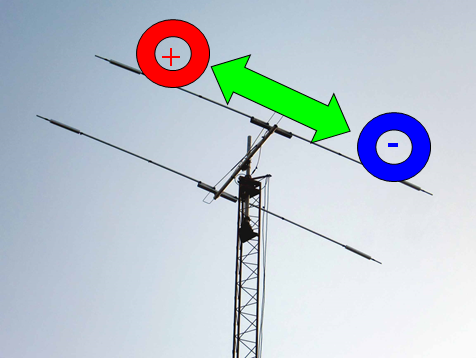
Figure 2(b): Traditional dipole antenna.
From now on, we describe the terahertz-wave emission mechanism of the coherent LO phonons. Here are schematic figures on coherent LO phonons: Figs. 3(a) and 3(b). The initial amplitude (desplacement) of LO phonons is created by the built-in electric field in the samples. This means the formation of the initial longitudinal polarization of the LO phonon. This satetus is shown in the top of Fig. 3(b). When the pump femtosecond-pulse beam illuminates the sample, the flow of the generated carriers occurs as shown in Fig. 3(a). The flow has an effect of screening, and then LO phonons osillates coherently as shown in the middle of Fig. 3 (b). As a resutl, the terahertz wave is emitted by the coherent LO phonons. This final stage is exhibited in the bottom of Fig. 3(b).
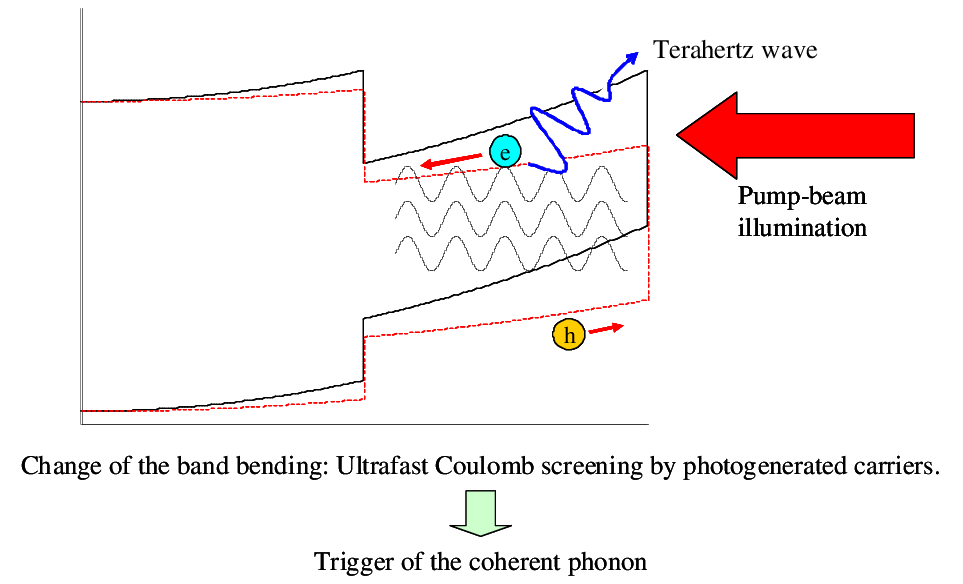
Figure 3(a): Schmetic exlplanation for generation mechanism of the terahertz emission from coherent LO phonons originating from the ultrafast Coloumb screening. The sinusoidal wave coresponds to the coherent LO phonons.
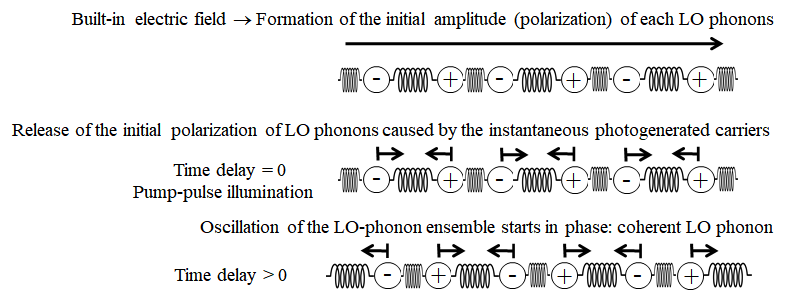
Figure 3(b): Time evolution of the coherent LO phonon amplitude (polaritzation).
We survey the terahertz wave emitted by the coherent LO phonons in an undoped GaAs/n-type GaAs epitaxial structure. The sample structure is shown in Fig. 4(a). This is quite simple. Figure 4 (b) shows the potential structure of the sample. The sample has a linear potential slope, so that the uniform electric field is present in the undoped GaAs layer.
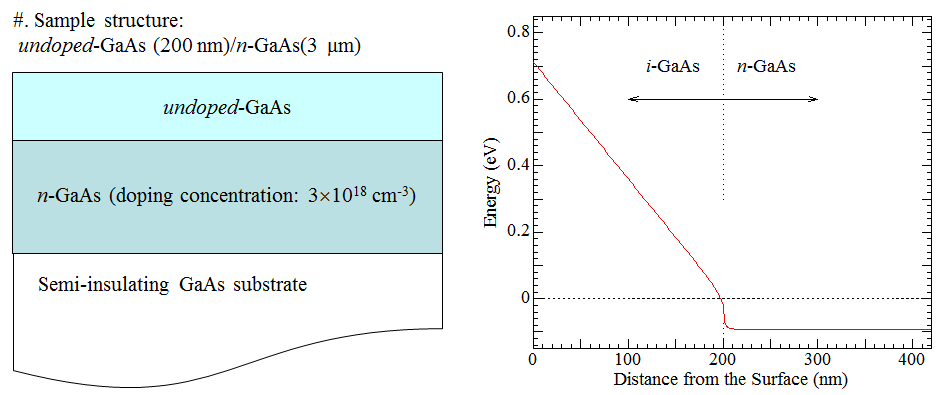
Figure 4: Sample structure and (b) Potential structure of the present sample.
Here, we demonstrate the first observation of the terahertz waves emitted from the coherent LO phonons from undoped GaAs/n-type GaAs epitaxial structure.
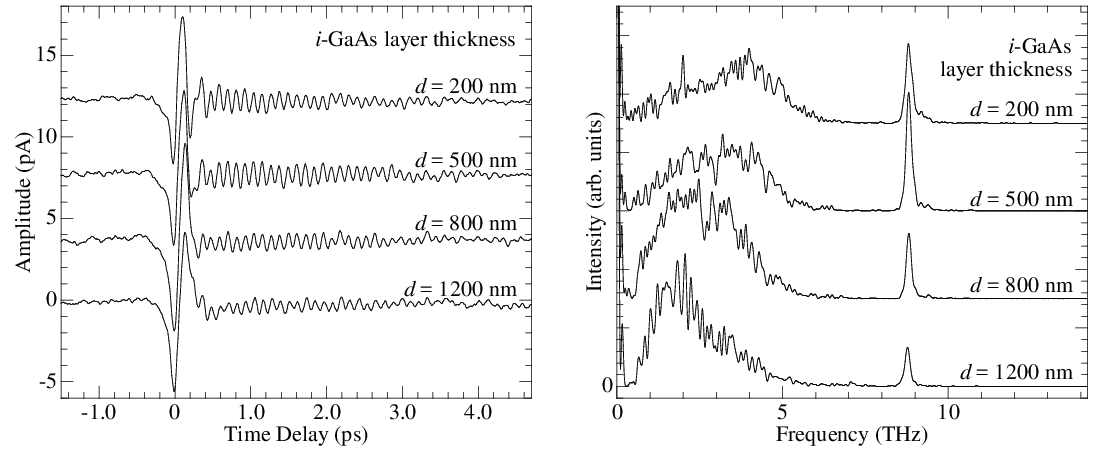
Figure 5(a) shows the time-domain terahertz waveforms of the samples. All the samples exhibit an intense monocycle oscillation around the time delay of 0 ps, the so-called first burst (bipolar pulse) resulting from the surge current of the photogenerated carriers. The Fourier power spectrum of each sample [Fig.5(b)] exhibits the two bands. The low frequency band is assigned to the band originating from the first burst. The coherent GaAs LO phonon at 8.8 THz is observed in the Fourier power spectra.
We mention that the ensemble of the high density photogenerated carriers forms the plasmons oscillating longitudinally. According to the well-know coupled vibration theory, the coherent LO phonon couples with the plasmon, and forms the LO-phonon-plasmon coupled mode
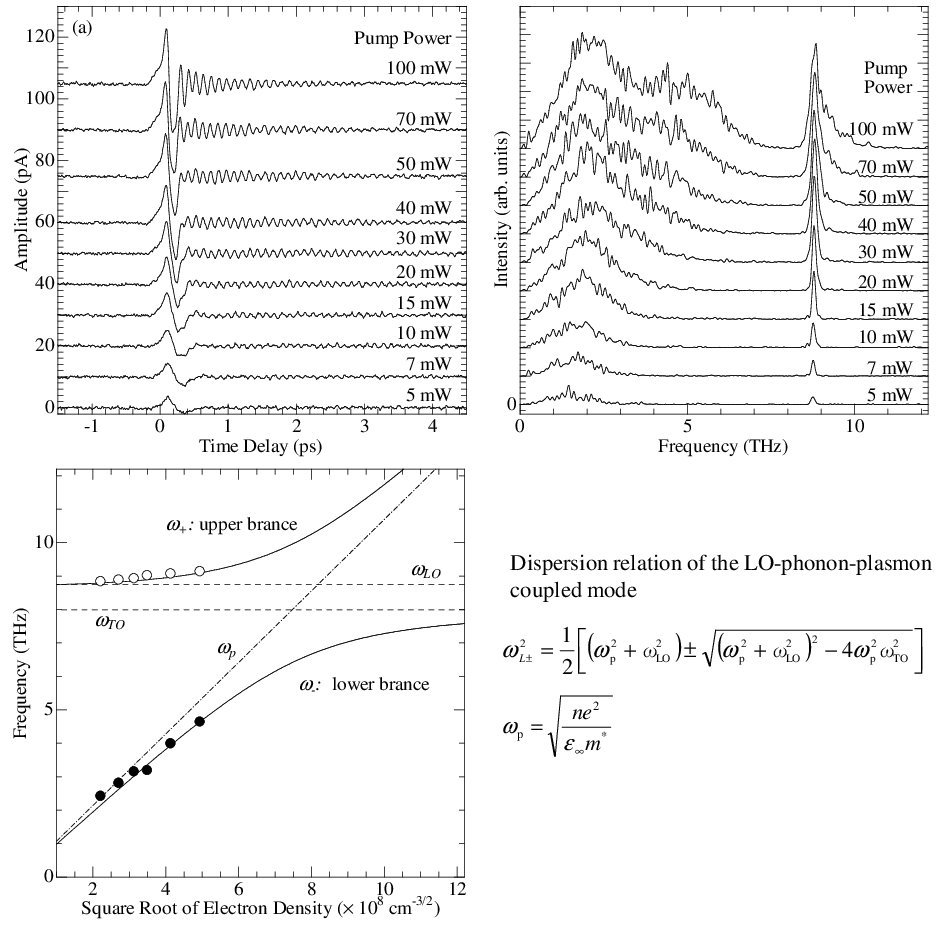
Terahertz time-domain waves shown in Figs. 6, The four Fourier power spectra are classifyed into two types: One is pump-power independent and the other is pump-power dependent. The sharp band at 8.8 THz obviously originates from the coherent LO phonon. The broad band with a peak at 2.2 THz is assigned to the bipolar pulse in the terahertz time-domain wave. The frequencies of these two bands do not depend on the pump power. Figure 6 shows the frequencies of the pump-power dependent two bands as a function of square root of electron density. The experimental data well agrees with the dispersion curves of upper and lower brances of the LO-phonon-plasmon coupled mode.
The research activities on terahertz waves/terahertz spectroscopy brought the following ** papers.
2 : List of outcomes
_Publications
1 "Enhancement of terahertz electromagnetic wave emission from an undoped GaAs/n-type GaAs epitaxial layer structure".H. Takeuchi, J. Yanagisawa, T. Hasegawa, and M. Nakayama.
Applied Physics Letters vol. 93, 081916 (2008).
# Link to the online-journal site
2 "Effects of nitrogen incorporation on a direction of a surface band bending investigated by polarity of terahertz electromagnetic waves in GaAs1-xNx epitaxial layers".
H. Takeuchi, J. Yanagisawa, J. Hashimoto, and M. Nakayama.
Journal of Applied Physics vol.105, 093539 (2009).
# Link to the online-journal site
3 "Intense emission of terahertz electromagnetic wave from an undoped GaAs/n -type GaAs epitaxial layer structure".
H. Takeuchi, J. Yanagisawa, T. Hasegawa, and M. Nakayama.
Physica Status Solidi (c) vol.6, pp.1513-1516 (2009).
-Proceedings of the 35th International Symposium on Compound Semiconductors, Rust, Germany (2008).
# Link to the online-journal site
3 : Posters and viewgraphs
1 "Intense emission of terahertz electromagnetic wave from an undoped GaAs/n-type GaAs epitaxial layer structur".
H. Takeuchi, J. Yanagisawa, T. Hasegawa, and M. Nakayama.
The 35th International Symposium on Compound Semiconductors (ICSC2008) September 21-24, 2008, Europa-Park, Rust, Germany.
*** Poster Presentation P34 (September 23, Tuesday) ***
The abstract is here. The poster is here.
2 "Direction reversal of the surface band bending in GaAs-based dilute ni-tride epitaxial layers investigated by polarity of terahertz electromagnetic waves".
Hideo Takeuchi, Junichi Yanagisawa, and Masaaki Nakayama.
The 14th International Conference on Narrow Gap Semiconductors and Systems (NGSS-14) July 13-17, 2009, Sendai, Japan.
*** Oral Presentation: Talk-8 (July 15, Wednesday) ****
The abstract is here. The viewgraph is here.